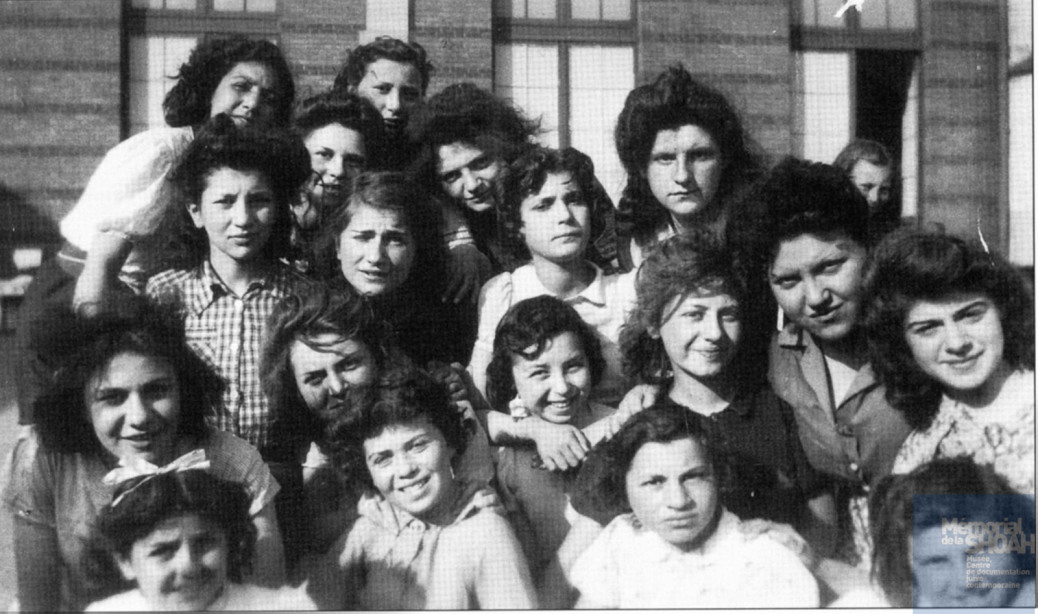Eva NADEL, née Chawa NADEL
Life in the Meurthe-et-Moselle department
The Nadel family originated in Poland: the father, Joseph Nadel, was born on March 27, 1890 in Krowica, in the east of the country and his mother, Sala Witmann, was born on September 22, 1892 in Keresiow. Their eldest son, Jacob, was born in 1924 in Holecze, also in Poland.

Photograph of the Micheville steel mills in around 1932. Source: industrie.lu/en
Sometime between 1924 and 1928, the Nadel family arrived in France, no doubt to escape poverty and anti-Semitism. They settled in Villerupt in the Meurthe et Moselle department. They first lived in the working-class housing estate of Cantebonne and then moved to the Clémenceau estate. Joseph Nadel worked as a laborer in the Micheville steel factory.
The family grew larger with the birth of Eva on March 22, 1928 in Villerupt. On her birth certificate, her first name is recorded as Chawa. Two boys were also born in Villerupt: Arnold in 1932 and Léon in 1935.
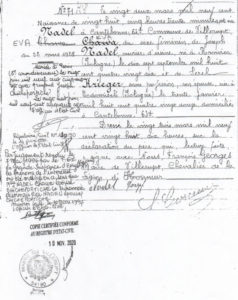
Copy of Eva Nadel’s birth certificate
In order to help them integrate more easily into French society, in 1935, Joseph Nadel applied for his children, who had been born in France, to be naturalized as French citizens. His request was granted and the children became French according to a decree dated July 9, 1936.
In addition, on the 1936 census records for Villerupt, all the children’s first names are given in their French form: Jacob is listed as Jean and Chawa is called Eva.

Extract from the 1936 census in Villerupt. Source: Meurthe et Moselle Departmental Archives.

Joseph Nadel’s application for French nationality for the three children born in Villerupt. Source: Convoy 77 association
Evacuation to the Vienne department
As early as 1935, as tension between Nazi Germany and the European democracies began to increase, the French government put together a plan to evacuate civilians living in the eastern border areas of the country. Between September 1, 1939 and September 1940, 60,000 people from the Moselle department were evacuated to 239 municipalities in the Vienne. (source: Vrid-memorial.com).
The Nadel family was evacuated in September 1939. They first stayed in Eglisottes, in the Gironde department, and moved to Doussay, in the Vienne department, on December 13, 1940.
On July 15, 1941 the family was arrested by the German police. Eva Nadel was released in December.
The records concerning Arnold Nadel show that the whole family was arrested again by the Germans in the spring of 1942, although the exact date is not given. They were interned in the camp on Limoges road in Poitiers. This camp had been set up in 1939 to take in Spanish refugees and then, from 1940 onwards, it became an internment camp for gypsies and Jews, prior to their deportation to the death camps.
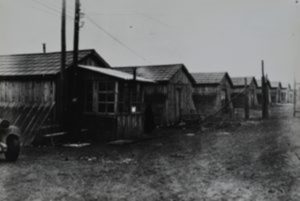
The internment camp on the Route de Limoges, in Poitiers. Source: Vienne Departmental Archives
Eva’s parents and her older brother, Jacob, were transferred to Drancy internment camp and then deported to Auschwitz on Convoy No. 32 on September 14, 1942. None of them survived.
We know from Robert Franck’s witness statement that a Jewish family in Châtellerault, the Weil family, had taken in Eva Nadel and that she went to school in the town. However, at the beginning of 1943, the commissioner of Châtellerault, following orders from the Vichy government, had all the Jewish children who had been separated from their parents arrested, on the grounds of “family reunification”. Eva was then sent to a children’s home run by the UGIF (Union Générale des Israelites de France, or Union of French Jews), on rue Lamarck in the 18th district of Paris. (Sources: “De bouche à oreille”, 2019, www.fondationshoah.org, and Robert Franck).
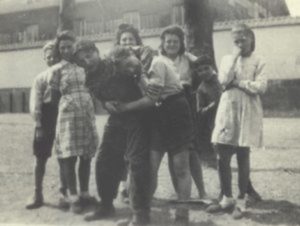
Eva Nadel is the third girl from the left, at the back. This photograph was taken at the UGIF center on rue Lamarck in Paris.. Source: Serge Klarsfeld
Eva’s arrest in Paris
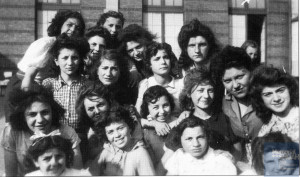
The photograph was taken at the UGIF center on avenue Secrétan in Paris. Eva Nadel is the second girl from the left in the second row. Source: Serge Klarsfeld
On April 21, 1944, following an Allied bombing that damaged the UGIF home on rue Lamarck, the children were moved to another UGIF center, the Lucien de Hirsch school on avenue Secrétan in the 19th district of Paris. Eva Nadel was 16 years old at the time.
During the night of July 21-22, 1944, roundups took place in all of the UGIF centers in Paris. Eva Nadel was arrested and taken to Drancy camp. She was assigned the number 25401. On July 31, she was deported with her younger brothers, Arnold and Léon, to Auschwitz on Convoy 77. This was the last large convoy from France, carrying more than 1300 deportees, including 324 children.
Eva’s deportation
Convoy 77 arrived in Auschwitz on August 5, 1944. Arnold and Leon, like all the other young children, were probably sent to the gas chambers as soon as they arrived.
Eva Nadel was selected for hard labor. She was tattooed with the number A16774. We have no further information about her life in the camp.
In December 1944, as the Red Army was advancing, the Nazis evacuated the prisoners from Auschwitz in order to employ them in arms factories further inside the Third Reich. Eva Nadel was sent on the so-called
Death March to the women’s camp at Kratzau, which was a sub-camp of the Gross-Rosen camp in Czechoslovakia. The inmates worked in nearby arms factories. She was held there until May 10, 1945, when she was liberated by the Russians.
Eva was repatriated to France on May 20, 1945.
Life after deportation
Eva Nadel lived at four different addresses in Paris. In 1948, she lived at 234, rue de Tolbiac and at 4, rue Guynemer. In 1954, she lived at 34, boulevard Saint Germain and by 1958 she was living at 8, rue des Bernardins. She worked as a secretary.
In 1957, she applied to the Ministry of Veterans Affairs for recognition of her status as a victim of war and a deportee.
On June 20, 1957, Eva married Armand Joseph Chicheportiche in the 5th district of Paris.
Her birth certificate reveals that a judgment delivered on May 7, 1996 by the court in Evry allowed her to change the name Chawa on her civil registry documents. From then on, she was officially named Eva Nadel and her birth certificate was amended accordingly.
In France, a birth certificate usually bears a note of the death of the person, but in Eva’s case, there is no record of her death. We therefore assume that she is still alive today. We have not given up hope of tracing her or her family via social networks. The publication of this biography may also help to put us in touch with people who knew her.

Memorial to Nazi victims in Villerupt
This plaque bears the name of the Nadel family along with all the other men and women from Villerupt who died in the Nazi camps between 1940 and 1944.
Contributors
This biography was written by the students of the 3B class of the André LALLEMAND junior high school in Pouilly-en-Auxois with the help of their history teacher, Ms. Garrec, and their French teacher, Ms. Jacquet.


 Français
Français Polski
Polski